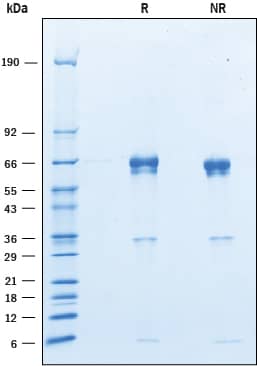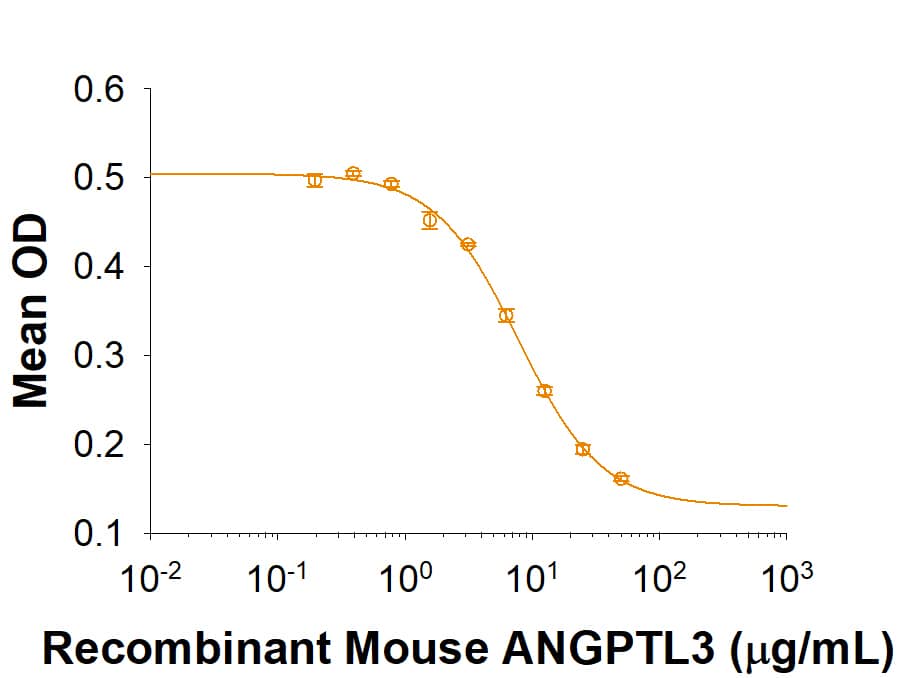Recombinant Mouse Angiopoietin-like 3 (HA-Tag) Protein, CF
R&D Systems, part of Bio-Techne | Catalog # 9899-AN

Key Product Details
Product Specifications
Source
Mouse myeloma cell line, NS0-derived mouse Angiopoietin-like Protein 3/ANGPTL3 protein
| Hemagglutinin Tag (YPYDVPDYA) |
Mouse Angiopoietin-like Protein 3 (Ser17-Thr455) Accession # Q9R182 |
| N-terminus | C-terminus |
Purity
>95%, by SDS-PAGE visualized with Silver Staining and quantitative densitometry by Coomassie® Blue Staining.
Endotoxin Level
<0.10 EU per 1 μg of the protein by the LAL method.
N-terminal Sequence Analysis
Tyr
Predicted Molecular Mass
52 kDa
SDS-PAGE
59-71 kDa and 33-38 kDa, reducing conditions
Activity
Measured by its ability to inhibit lipoprotein lipase activity. Yoshida, K. et al. (2002) J. Lipid Res. 43:1770.
The IC50 value under conditions in which Recombinant Human Lipoprotein Lipase (Catalog # 9888-LL) is present at 0.5 μg/mL, and p‑nitrophenyl butyrate concentration is 1 mM in 0.1 M sodium phosphate, 0.15 M NaCl, 0.5% Triton® X-100, pH 7.2, is 2-10 µg/mL.
The IC50 value under conditions in which Recombinant Human Lipoprotein Lipase (Catalog # 9888-LL) is present at 0.5 μg/mL, and p‑nitrophenyl butyrate concentration is 1 mM in 0.1 M sodium phosphate, 0.15 M NaCl, 0.5% Triton® X-100, pH 7.2, is 2-10 µg/mL.
Scientific Data Images for Recombinant Mouse Angiopoietin-like 3 (HA-Tag) Protein, CF
Recombinant Mouse Angiopoietin-like 3 (HA-Tag) Protein Bioactivity
Recombinant Mouse ANGPTL3 (Catalog # 9899-AN) dose dependently inhibits Recombinant Human LPL (Catalog # 9888-LL) activity with an IC50of 2-10 µg/mL.Recombinant Mouse Angiopoietin-like 3 (HA-Tag) Protein SDS-PAGE
2 μg/lane of Recombinant Mouse Angiopoietin‑like Protein 3 was resolved with SDS-PAGE under reducing (R) and non-reducing (NR) conditions and visualized by Coomassie® Blue staining, showing bands at 59 - 71 kDa and 33 - 38 kDa.Formulation, Preparation and Storage
9899-AN
| Formulation | Lyophilized from a 0.2 μm filtered solution in PBS, NaCl and CHAPS with Trehalose. |
| Reconstitution |
Reconstitute at 400 μg/mL in water.
|
| Shipping | The product is shipped with polar packs. Upon receipt, store it immediately at the temperature recommended below. |
| Stability & Storage |
|
Background: Angiopoietin-like Protein 3/ANGPTL3
References
- Li, C. (2006) Curr. Opin. Lipidol. 17:152.
- Oike, Y. et al. (2004) Int. J. Hematol. 80:21.
- Kersten, S. (2005) Biochem. Soc. Transact. 33:1059.
- Conklin, D. et al. (1999) Genomics 62:477.
- Ge, H. et al. (2005) J. Lipid Res. 46:1484.
- Ono, M. et al. (2003) J. Biol. Chem. 278:41804.
- Koishi, R. et al. (2002) Nat. Genet. 30:151.
- Shimizugawa, T. et al. (2002) J. Biol. Chem. 277:33742.
- Koster, A. et al. (2005) Endocrinology 146:4943.
- Inaba, T. et al. (2003) J. Biol. Chem. 278:21344.
- Shimamura, M. et al. (2004) Biochem. Biophys. Res. Commun. 322:1080.
- Fugier, C. et al. (2006) J. Biol. Chem. 281:11553.
- Camenisch, G. et al. (2002) J. Biol. Chem. 277:17281.
- Zhang, C.C. et al. (2006) Nat. Med. 12:240.
Alternate Names
AGNPT5, Ang-5, Angiopoietin-5, ANGPTL3
Gene Symbol
ANGPTL3
UniProt
Additional Angiopoietin-like Protein 3/ANGPTL3 Products
- All Products for Angiopoietin-like Protein 3/ANGPTL3
- Angiopoietin-like Protein 3/ANGPTL3 cDNA Clones
- Angiopoietin-like Protein 3/ANGPTL3 ELISA Kits
- Angiopoietin-like Protein 3/ANGPTL3 Lysates
- Angiopoietin-like Protein 3/ANGPTL3 Primary Antibodies
- Angiopoietin-like Protein 3/ANGPTL3 Proteins and Enzymes
- Angiopoietin-like Protein 3/ANGPTL3 Simple Plex
Product Documents for Recombinant Mouse Angiopoietin-like 3 (HA-Tag) Protein, CF
Product Specific Notices for Recombinant Mouse Angiopoietin-like 3 (HA-Tag) Protein, CF
For research use only
